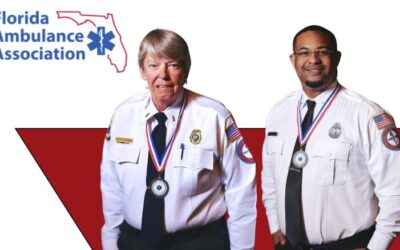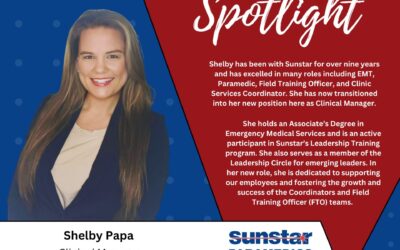It is impossible to fully anticipate how to best handle a disaster, but EMS providers can prepare with training and careful planning. Part of this preparation involves maintaining vehicles and equipment to address disaster scenarios.
Sunstar Paramedics in Pinellas County, FL, serves a population of one million and responds to more than 180,000 calls a year, with more than 150,000 of those calls requiring transports. The agency uses four specialty vehicles to accommodate high patient volume and decrease response time in a disaster or mass casualty incident. Recently, a specialty vehicle was deployed to a local movie theater where 70 people needed immediate medical treatment after being accidentally exposed to pepper spray.
In addition to their response capabilities, these vehicles and their team members can serve proactive community roles by being present for events with hundreds or thousands of attendees, like marathons, triathlons, outdoor events, offshore boat races and festivals. Pinellas County is home to 24 cities and three sports stadiums, so mass gatherings happen almost every day.
Building a highly trained team and selecting the right vehicles can help any community take additional steps toward preparing for a potential disaster.
Determining Specialty Vehicle Needs
Each community has distinct needs. Mountainous areas will have a greater need for vehicles that can drive on rocky terrain, while communities in the Northeast need vehicles equipped to handle large amounts of snowfall.
Pinellas County’s subtropical climate and geographic location puts it at high risk for tropical storms and hurricanes, so Sunstar needed vehicles that could provide shelter and drive in heavy rain and strong wind.
In terms of special events like marathons and outdoor concerts, Sunstar identified an increased risk of dehydration, heatstroke and other heat-related injuries. A large role for the specialty vehicles is to provide an on-site location where multiple patients can quickly receive IV fluids and water in order to reduce hospital transports.
Selecting and Customizing Specialty Vehicles
Sunstar’s largest vehicle is a five-ton 2004 International 4300 truck used for immediate response to mass casualty incidents. The truck’s high ground clearance allows it to access flooded areas and its hydraulic lift gate moves supplies quickly. It is equipped with metal cages that contain load plans for specific incidents.
“The larger truck has supplies for every type of situation,” says Jeff Knight, Sunstar’s operations supervisor who oversees the staffing and operations of these response vehicles. “We want to be prepared to deploy it right away. So whether the incident requires Level ‘C’ PPE sustainment, CHEMPACK nerve agent antidote kits, spinal motion restriction equipment or triage, the truck is already stocked and ready to go.”
 Sunstar uses heavy-gauge rolling metal carts to hold supplies and equipment. Much like an emergency room supply cart, these carts can be dropped off at locations so paramedics and EMTs can work directly from them on scene or in shelters.
Sunstar uses heavy-gauge rolling metal carts to hold supplies and equipment. Much like an emergency room supply cart, these carts can be dropped off at locations so paramedics and EMTs can work directly from them on scene or in shelters.
Ten paramedic gear bags are kept on the truck for rapid initial response to avoid using equipment from the responding ambulances. This allows for the paramedics and EMTs responding to mass casualties to have supplies onscene while keeping the necessary equipment on the ambulance for transports and redeployment.
This truck is also equipped with hurricane shelter supplies. There are ten general shelters that are stocked with basic medical supplies and three special-needs shelters. Each shelter can accommodate 1,000 people.
“Pinellas County has a high population of senior citizens, who usually have more complex medical needs,” says Knight. “It is important that our shelters are equipped with special equipment and supplies to provide extensive medical care should there be a disaster.”
In addition to responding to emergency situations in Pinellas County, this truck can be deployed to other areas in need of assistance. Sunstar used this truck to transport medical supplies to crews in New Orleans to help aid relief efforts after Hurricane Katrina.
Sunstar’s second truck is a 2005 Chevrolet C4500 utility vehicle equipped with cots, tents, misting fans, water and ice, lighting and a generator. This truck is mainly used for rehab with second-alarm or greater structure fires and to support special operations–tactical EMS, the hazardous materials response team and the technical rescue team.
The utility truck is usually accompanied by a 2005 Wells Cargo utility trailer, which contains a diesel generator. The trailer is used to transport medical supplies, and serve as a command post or patient assessment area once the EMS crew arrives on scene. The air-conditioned interior and large awning provide emergency shelter in hot temperatures. It is regularly used to provide shade for the SWAT team at training events.
The fourth vehicle is a 2005 Kubota RTV900 all-terrain vehicle (ATV), which is used to transfer patients when an ambulance or fire truck cannot reach them. The Kubota is particularly useful in Pinellas County because ambulances and fire trucks cannot be driven on the beach, but the ATV can.
“Trying to carry a patient on a stretcher through a large crowd can be dangerous,” says Knight. “The Kubota allows us to safely transport a patient back to the treatment area or ambulance.” The original dump-truck style back was refurbished to hold a stretcher and medical equipment.
Building a Team
 Approximately 30 Sunstar paramedics and EMTs are part of the specialty-response vehicle team. Each team member is selected by Sunstar leadership and completes specialized training that teaches effective triage skills how to handle large events and drive the vehicles. Mock disaster drills are held to assess each candidate’s aptitude during the application process.
Approximately 30 Sunstar paramedics and EMTs are part of the specialty-response vehicle team. Each team member is selected by Sunstar leadership and completes specialized training that teaches effective triage skills how to handle large events and drive the vehicles. Mock disaster drills are held to assess each candidate’s aptitude during the application process.
The team has a strategy meeting before each event to review the elements of the event and create treatment plans for different scenarios. This allows the team to be prepared for any immediate needs, while providing continued training for disaster response.
“We do our best to be fully prepared for any situations,” said Knight. “You never know what you are going to get, so we try to plan for every possible scenario.”
Criteria for Use
It is important for each community to assess its needs and establish criteria for an EMS presence at special events. Pinellas County’s warm climate makes it possible to hold large-scale events year-round, which makes outdoor concerts, festivals and marathons popular weekend activities.
Any scheduled event in Pinellas County is eligible to request that Sunstar’s specialty trucks be present, but the first step is determining if that is necessary, as providing specialty vehicles and staff for every event would place a large strain on Sunstar’s system and team. The director of operations must determine if the specialty vehicles are necessary at the event, or if a single ambulance would suffice.
Once it’s decided that the event requires the specialty vehicles, Knight and his team work with the event’s logistics team to determine which vehicle is best suited for the event. The weather forecast, location and projected attendance are just a few of the factors that are analyzed when assigning the vehicles.
The vehicles can be used in multiple combinations, depending on what the event requires. Sunstar supplies medical stand-by for multiple events per month, often in conjunction with the local fire department. As an example, the utility truck and trailer were used when President Obama visited St. Petersburg College on his campaign tour. Thousands of people attended the outdoor event, which had little shade on a hot day. Sunstar had coordinated with the venue in advance, and checked the weather to know what to expect. The trailer was used as a cooling station where 65 people were hydrated and cooled with misting fans. The use of the trailer reduced the need to transport patients for further care. Only 17 people needed to be transported from the event for additional care.
Strategic Placement
The final component for consideration is the placement. Just as the needs of each community are different, the geographic makeup and challenges are distinct for each community. Pinellas County is a peninsula, connected to the mainland at its northern border, with a high-risk flood zone running through the middle. In the event of a hurricane, the southern half of the county could be completely separated by impassable body of water, creating a solitary island.
Sunstar strategically places hurricane shelters and emergency response vehicles throughout the county to prepare for this scenario. All four vehicles are stationed at Sunstar’s headquarters in Largo, which is centrally located within Pinellas County. In the event of a hurricane, the five-ton truck is moved to the southern part of the county because, unlike ambulances, it can maneuver through high levels of standing water to reach patients. Sunstar also has supplies for specific incidents stored at off-site shelters throughout Pinellas County.
This column originally appeared in the July issue of EMS World. To view the original column, please click here.



